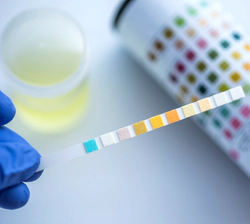What Drugs Are Working Americans Testing Positive For?
Quest’s annual release of workplace drug test results helps inform American employers of the level of impairment experienced by the average worker.

Every year, the national laboratory and testing company Quest Diagnostics issues a report on the results of national drug tests in the workplace. From an analysis of this information, we can get an idea of how frequently working Americans are using drugs and what drugs they are using.
In early 2023, Quest Diagnostics published its report for 2022 drug tests.1 They provide many different breakdowns of this data gained from drug tests administered across the country that help us gain a better understanding of the national situation.
In their analysis, workplace drug test results are separated into two major groups:
- The general working population
- The safety-sensitive workforce, including federal employees, those working in nuclear power, and transportation workers such as pilots, truck drivers and train conductors
Among all groups and including all tests completed, the percentage of positive drug tests in 2022 was the highest since 2001 at 4.6% positivity.
Between 1988, when Quest began compiling these numbers, and 1999, numbers were higher. Sometimes they were much higher, as you can see here:
Percentage of positive tests
- 1988 13.6%
- 1989 12.7%
- 1990 11.0%
- 1991 8.8%
From there, the percentage dropped to 5.0% or less by 1997.
The lowest percentages were seen from 2010 to 2012 when the number was 3.5% for all three years.
What Drugs Are Showing Up in These Tests?

Among those in sensitive positions, these are the drugs showing up most frequently among tests that were positive for any drug.
- Marijuana 35.2%
- Amphetamines 26.8%
- Cocaine 7.6%
- All Opioids 5.14%
Among the general working population, here is the breakdown of drugs showing up among positive drug tests.
- Marijuana 56.1%
- Amphetamines 23.6%
- All Opioids 19.34%
- Cocaine 3.6%
- Benzodiazepines 3.4%
It’s not surprising that the numbers are higher among the general working population as those in sensitive industries have good reasons to refrain from drug use. Those employees would know that they are more likely to be drug-tested.
- Amphetamines would include illicit drugs like methamphetamine or prescription drugs like Ritalin, Adderall, or Desoxyn.
- Benzodiazepines include Valium, Xanax, alprazolam, lorazepam and similar drugs.
- Opioids include heroin, morphine, oxycodone, methadone and hydrocodone.
Marijuana Positives Among Nearly Nine Million Total Tests
Among all the six million workplace drug tests performed among the general working population, 4.3% tested positive for marijuana. This is the highest positive rate ever recorded by these tests.
Among nearly three million federally-mandated workplace drug tests, just under one percent of tests were positive for marijuana.
Why Are Workers Tested?
There are several categories of workplace drug tests.
- Pre-employment
- For cause: There have been signs that a person is unfit for work or unsafe work behavior has been documented
- Post accident: An employee was involved in a workplace accident or unsafe practices
- Post-rehab: A person has been off work for drug addiction treatment
- Random: An unpredictable pattern of testing used as a deterrent
All these categories were taken into consideration in these drug test results.
The Importance of These Test Results
This report reveals what employers and executives are dealing with as they try to keep businesses profitable, viable and, of course, safe for all employees. When analyzed by Human Resources departments, patterns can be detected so policies can be developed that keep all employees safer.
A review of this report also allows any American to take the pulse of our country and get a sense of whether our national drug problems worsening or getting better.
Post-Accident Drug Tests

What about those employees who had accidents? What drugs were present? Not surprisingly, the top drug present in post-accident tests is marijuana. Among post-accident tests, 7.3% were positive for marijuana. This number has more than doubled in the past ten years.
In a news release, Quest points out that increases in post-accident, marijuana-positive tests have increased in a corresponding manner with the legalization of this drug in many states.
Workers may feel they can safely consume or be affected by marijuana while they were working but they would be wrong. The THC in marijuana creates all these adverse effects on employees:
- Poorer depth perception
- Slower reaction time
- Impaired coordination
- Impaired motor skills
Use is also associated with these employee problems:
- Decreased productivity
- Higher worker compensation claims
- Higher unemployment claims
- More accidents
- Higher rate of injuries
- More absenteeism
Therefore it is easy to see why personnel directors would want to know if their employees were using marijuana or any drug.
Widespread Legalization of Marijuana

At the time this report was issued in early 2023, marijuana had been legalized for medical use in 38 states and for recreational use in 19 states. It was only logical that positive test results were higher in states that legalized medical use, recreational use or both.
Overall, positive marijuana tests increased nearly 12% in states with legal recreational marijuana. In states where only medical use of marijuana is legal, the number of positive tests increased by 8.3%. When neither use was legal, positive tests only increased 3.3%.2
Drug or Alcohol-Related Deaths in the Workplace
Nearly 800 people died at work after they were exposed to harmful substances. However, this doesn’t mean that their work environments released toxins that killed them. The majority of these deaths (464) were the result of workplace abuse of drugs or alcohol. This was slightly higher than the number the year before.3
Of course. considering the impairments caused by many drugs, it is possible that workplace deaths involving machinery, transport or falls could also be influenced by drug or alcohol use.
Which Industries Were the Most Affected?
Quest sorts these positive drug tests by industry as well. Of all the tests done in the following industries, these are the positivity percentages for all drugs:
- Retail Trade 7.7%
- Accommodation and Food Services 7.0%
- Health Care and Social Assistance 5.3%
- Transportation and Warehousing 5.3%
- Construction 4.7%
- Manufacturing 4.5%
- Public Administration 4.0%
- Finance and Insurance 3.6%
For three categories—Accommodation and Food Services, Retail Trade and Finance and Insurance—these numbers increased approximately 40% or more compared to the rate of positivity in 2018.
In two of these industries—Retail Trade and Accommodation and Food Services—the rate of drug tests positive for marijuana increased by more than 100% in just five years.
What Action Should American Businesses Take?
Once they know this information, how should businesses react? That’s a question that only business owners, executives and HR departments can answer. It is certain that increasing drug use harms both businesses and the individuals using the drugs.
Businesses can establish strict workplace policies in writing and notify staff as they are hired that they are subject to drug testing at random or for cause. Individuals who are notified up front and don’t want to be tested are free to apply at other companies. Owners can establish Employee Assistance Programs to provide a safety net for staff found using drugs. This program helps the person find a good drug rehab and assists them through the process of getting sober and returning to the company.
Employees can also be provided with relevant, impactful education about the problems caused by drug abuse. There are many other suggestions for building a drug-free and safe workplace provided by the Substance Abuse and Mental Health Services Administration.4
The more drug-free the workplace, the safer it is for every employee, executive and customer.
Sources:
-
“Drug Testing Index 2023 data tables.” Quest Diagnostics, 2023. Quest ↩︎
-
“Post-Accident Workforce Drug Positivity for Marijuana Reached 25-Year High in 2022, Quest Diagnostics Drug Testing Index Analysis Finds.” Cision PR Newswire, 2023. Cision ↩︎
-
“National Census of Fatal Occupational Injuries in 2021.” Bureau of Labor Statistics, 2022. BLS ↩︎
-
“Plan and Implement a Program.” Substance Abuse and Mental Health Services Administration, 2022. SAMHSA ↩︎






 ®
®